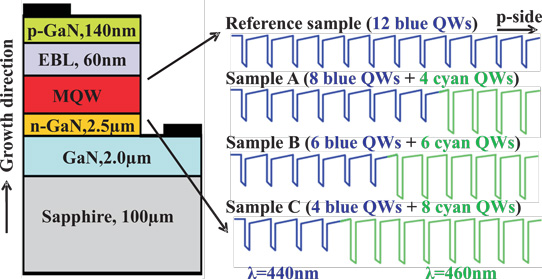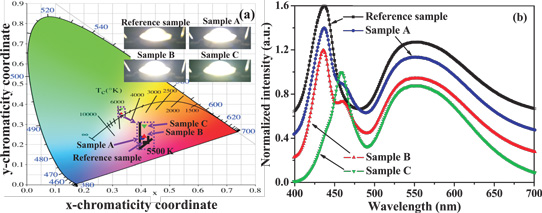- News
29 October 2015
Improving color and lifting droop from white light-emitting diodes
Xi'an Jiaotong University and Shaanxi Supernova Lighting Technology Co Ltd in China have reported reduced droop and improved color rendering in white light-emitting diodes that use a multiple quantum well (MQW) structure with 440nm blue and 460nm cyan wells [Yukun Zhao et al, J. Appl. Phys., vol118, p145702, 2015].
The combination of blue and cyan, along with a suitable phosphor, improved the color rendering index (CRI) to 77.0, compared with 66.4 for a pure blue device. The cyan/blue device was therefore much closer to the 80 CRI US Energy Star specification for indoor white light.
The deeper cyan wells are also thought to ameliorate problems associated with low hole carrier concentrations across an MQW structure caused by low mobility compared with electron carriers. Precision measurements of light emission from indium gallium nitride (InGaN) MQWs under current injection often show that significant levels of radiation come from just the wells next to the p-contact layers.
In the Xi'an Jiaotong/Shaanxi Supernova LEDs, the cyan wells are believed to form a reservoir for holes that can be injected into the blue wells lower down in the device structure (Figure 1). The epitaxial samples were prepared through metal-organic chemical vapor deposition (MOCVD) on sapphire. The active region contained 12x 3nm wells and 12nm GaN barriers. The electron-blocking layer (EBL) consisted of aluminium gallium nitride (AlGaN).

Figure 1: Schematics for LEDs with conventional uniform and dual-wavelength MQW structures.
Various combinations of cyan (In0.18Ga0.82N) and blue (In0.15Ga0.85N) were produced. The higher indium content of the cyan wells was achieved by reducing the growth temperature to encourage greater indium incorporation.
LED chips were fabricated with an indium tin oxide (ITO) current-spreading layer and dimensions 250μmx580μm. For white light, the chips were encapsulated in oxynitride phosphor (ZYP570N, www.beijingyuji.com/EN-led-Oxynitride-Yellow-Phosphor/239.html).
Simulations suggested that the configuration of 6 cyan and 6 blue wells (Sample B) should have the best combination of increased electron and hole concentrations across the MQW assembly. Further, the reservoir effect of the cyan wells enables stronger injection of holes into the blue region of the MQW. Sample B also had a higher EBL electron barrier, inhibiting overspill of electrons into the p-GaN contact. At the same time, the EBL had a lower barrier to hole injection.
Table 1: Experimental results of IQE and droop ratios at 80A/cm2.
| Peak intensity ratio | IQE (80A/cm2) | IQE (max) | Q (80A/cm2) |
| Reference sample | 37.8% | 76.0% | 50.3% |
| Sample A | 42.2% | 75.2% | 43.9% |
| Sample B | 48.3% | 79.8% | 39.5% |
| Sample C | 38.0% | 85.5% | 55.6% |
Although LED sample C had the highest peak internal quantum efficiency (IQE), the highest efficiency at 80A/cm2 current density was achieved by LED B (Table 1), corresponding to the lowest droop ratio (Q). The poor performance of sample C LEDs at high current was probably due to increased threading dislocation densities, as suggested by x-ray analysis.

Figure 2: (a) CIE 1931 chromaticity diagram and (b) normalized experimental EL spectra of four encapsulated LED samples with phosphors at 80A/cm2. Insets of four LED samples radiating on probe platform.
Sample B also produced the best CRI in encapsulated devices (Table 2, Figure 2). The correlated color temperature (CCT) was also close to pure white (5500K). The better color performance of sample B devices is attributed to greater intensity of the longer 460nm wavelength giving a CRI enhancement.
Table 2. Color rendering and temperature at 80A/cm2.
| Sample | Reference | A | B | C |
| CIE (x, y) | 0.3289, 0.3395 |
0.3239, 0.3482 |
0.3269, 0.3498 |
0.3273, 0.3726 |
| CCT (K) | 5660 | 5868 | 5737 | 5698 |
| CRI | 66.4 | 75.6 | 77.0 | 74.7 |
White LEDs InGaN InGaN MQW MOCVD
http://dx.doi.org/10.1063/1.4933070
The author Mike Cooke is a freelance technology journalist who has worked in the semiconductor and advanced technology sectors since 1997.


